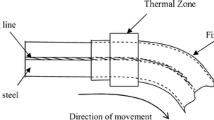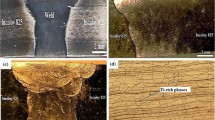Abstract
In this study the effects of alloying elements on the microstructure and mechanical properties of 600MPa grade FCAW-S weld metals containing 2% Ni were examined. Carbon, manganese and aluminum contents were varied in the ranges of 0.075%–0.101%, 1.19%–1.69%, and 0.66%–1.49% respectively. Regardless of the Al content, all of the weld metals showed a bainite dominant microstructure with no δ-ferrite. This indicates that when a weld metal contains 2% Ni, the Al content can be increased up to around 1.5% without concern about the deterioration of impact toughness due to the presence of δ-ferrite. The tensile strength of the weld metals varied from 595 MPa to 702 MPa dependent upon the chemical composition. Multiple regression analysis showed that while C and Mn have strong influences on the tensile strength, Al has little influence. Therefore, the Pcm index of weld metals could be used as an indication of their tensile strength. Impact toughness of the weld metals was influenced most by tensile strength and showed that the 50J transition temperature increased by 36 °C when the tensile strength was increased by around 100 MPa. Therefore, an excessive increase of the tensile strength should be avoided to attain higher impact toughness. Even when inclusion mean diameters were increased from 0.588 μm to 0.708 μm with an increase of the Al content from 0.66% to 1.49%, the size difference showed little influence on the impact toughness of the weld metals in this experiment.
Similar content being viewed by others
References
H. I. Kaplan and D. C. Hill, Weld. J. 55, 13s (1976).
O. Morigaki, T. Matsumoto and Y. Takemoto, Weld. J. 55, 241s (1976).
D. J. Kotecki and R. A. Moll, Weld. J. 49, 157s (1970).
D. J. Kotecki and R. A. Moll, Weld. J. 51, 138s (1972).
J. C. Gonzalez, C. L. Llorente and H. Biloni, Can. Metall. Q. 25, 319 (1986).
H. Hatano, A. Yamamoto, S. Koishi, and K. Morimoto, Proc. of the National Meeting of JWS. p.502, Japan Welding Society (2009).
L. L. J. Chin, Weld. J. 48, 290s (1969).
Ø. Grong, A. O. Kluken, and B. Bjornbakk, Join. & Mat. Oct., 164 (1988).
M. A. Quintana, J. McLane, S. S. Babu, and S. A. David, Weld. J. 80, 98s (2001).
A. W. Cramb and I. Jimbo, Iron & Steelmaker 16, 43 (1989).
K.-Z. Min, J.-H. Lee, K.-S. Kim, and D.-H. Lee, Korean J. Met. Mater. 49, 766 (2011).
Author information
Authors and Affiliations
Corresponding author
Rights and permissions
About this article
Cite this article
Bang, KS., Kil, W. & Chang, WS. Effects of chemical composition on the microstructure and mechanical properties of FCAW-S weld metal containing 2% Ni. Met. Mater. Int. 19, 329–334 (2013). https://doi.org/10.1007/s12540-013-2030-1
Received:
Accepted:
Published:
Issue Date:
DOI: https://doi.org/10.1007/s12540-013-2030-1




